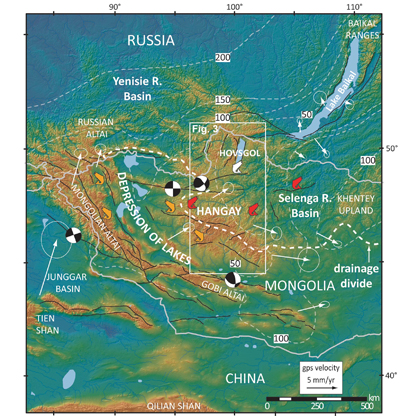Western Mongolia and adjacent parts of central Asia currently accommodate ~10 mm/yr of northward-directed shortening related to the India-Asia collision. The Hangay Mountains occur in a kinematic transition between predominantly compressional deformation to the south and extensional deformation to the north. The northern margin of the plateau and adjacent parts of the Siberian Craton are dominated by the active Baikal and Hovsgol intracontinental rifts.
 Situated in this complex juncture between regions of active shortening and extension, the Hangay Mountains and trans-Hovsgol ranges occupy a broad domal upland (~425,000 km2) containing the embedded Hangay Dome, (~200,000 km2) a largely intact block-uplift, flanked by major, currently active strike-slip faults. The high interior of the dome sits at elevations ~1.5 km above the regional trend and locally reaches elevations of up to 4000 m. To the southwest, the internally drained Mongolia Depression of Lakes and Valley of Lakes lie between the Hangay uplift and the Altai ranges.
Situated in this complex juncture between regions of active shortening and extension, the Hangay Mountains and trans-Hovsgol ranges occupy a broad domal upland (~425,000 km2) containing the embedded Hangay Dome, (~200,000 km2) a largely intact block-uplift, flanked by major, currently active strike-slip faults. The high interior of the dome sits at elevations ~1.5 km above the regional trend and locally reaches elevations of up to 4000 m. To the southwest, the internally drained Mongolia Depression of Lakes and Valley of Lakes lie between the Hangay uplift and the Altai ranges.
The high topography of the Mongolian Plateau and Hangay Dome has been variably attributed to far-field effects of India-Asia convergence, Pacific plate subduction, propagation of rifting southward from Lake Baikal, isolated mantle-plume activity, lateral mantle flow and upwelling at the southern edge of the Siberian Craton, lithospheric delamination, and/or the presence of underplated magmatic rocks at the base of the crust.
